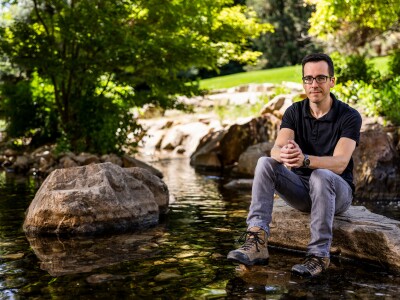Student-created device produced by Engineering Capstone program

Children diagnosed with autism often have difficulty making eye contact, which can inhibit their ability to create and maintain fulfilling social relationships. Research has also shown that social communicative gestures, such as eye contact and pointing, are building blocks to language development.
Hoping to create a tool to assist, a BYU Engineering Capstone team and their sponsor have created a pair of glasses, worn by a therapist, that display dynamic animated images on the lenses, potentially increasing the engagement and comfort of the child as they work to improve eye contact. And while children diagnosed with autism should never be forced to make eye contact, which could cause unnecessary stress or discomfort, some therapists
The inspiration for the glasses came to sponsor Heidi Kershaw during a therapy session with her son, who has autism. Kershaw remembers her son struggling to complete the therapy exercises while simultaneously being entranced by a Mickey Mouse show on the TV.
“I told the therapist, ‘If I could just have a pair of glasses that streamed content into the lens, I would wear them so that I could finally see my boy’s eyes,’” she recalls.

Kershaw reached out to engineering firms around the world and received similar responses from all of them: the technology was impossible and would cost $1 million for development without any guaranteed outcome or results. Somewhat serendipitously, Kershaw was connected with BYU Capstone through a friend, and began working with the team of three mechanical engineering students and three electrical engineering students. In a matter of weeks, the team had developed two possible prototypes.
The chosen design utilizes two LCD screens, two small sheets of teleprompter glass and a speaker. The glasses are connected to a control box, which allows for opacity control of the animation by the user. With low opacity, the user’s eyes will be visible to the child, allowing for an opportunity to engage in eye contact after already being engaged in an animation at high opacity.
“From the outset, we could feel the importance and potential life-changing impact these glasses could have on the lives of children with autism and their families,” said Capstone team member Matt Simmons. “We are all so grateful to have had the opportunity to make this idea become a reality. Our hope is that therapists who work with children with autism will use these glasses to create that positive experience and help these wonderful children continue to develop.”
The team also explored the idea of using mini transparent OLED screens, as they are lightweight and look more like normal glasses. However, OLED screens would restrict the animations to low resolution and monochromatic colors and could blind the user at full opacity. The team suggests that as technology improves, OLED screens could become a viable option.
Kershaw believes this product is one more tool doctors and communities around the world can use to further understand the needs of children with autism. These glasses could prove a helpful tool for therapists, parents, and children who believe eye contact skills would improve their overall wellbeing.
“Not only do I see the need of these kids who want to connect but don’t know how, but the need of parents who want to connect with their child. They’re desperate for it,” Kershaw said. As the current SVP of Operations at the Entertainment Industry Foundation in Los Angeles, and the former president of a non-profit that supports arts education, Kershaw plans to refine the design and move forward with mass manufacturing in hopes of making this product available to front-line therapists and parents of children with autism.
“I’m hungry to help the world see how much potential is in every single autistic child, every single autistic adult,” she said. “These are phenomenal people. They want to connect with others, and they don’t have the inherent tools to know how to do that.”
Unfamiliar with BYU's Capstone program? Read about their past and future projects here at https://capstone.byu.edu




